

Agenda of Economic Security Reforms Supporting Low-Wage Working Families Working Poor Families Project Cross State Meeting Strengthening State Policies December 6, 2005 Maurice Emsellem National Employment Law Project (510) 663-5700 emsellem@nelp.org
Percent of Jobless Collecting State Unemployment Benefits (2001-2003) National Employment Law Project 2 www.nelp.org
Major Shift Toward State Policies Filling the Gaps in the UI Program � Since 1999, the movement to fill the gaps in the UI program to benefit low-wage and women workers has reached half the states. � State Reform Highlights: - 12 new states count a worker’s recent earnings to qualify for benefits (“alternative base period”). - More than half the states allow workers to collect unemployment while seeking part-time (not just full- time) work. - 23 new states have adopted coverage for workers who leave their jobs due to domestic violence and other “family friendly” reforms. National Employment Law Project 3 www.nelp.org
Alternative Base Period Expands to 20 States, Covering Nearly Half the Nation’s UI Claims National Employment Law Project 4 www.nelp.org
Estimated Numbers Collecting UI Due to the Alternative Base Period (2003) 500,000 439,000 450,000 400,000 350,000 300,000 250,000 211,000 200,000 150,000 100,000 50,000 0 Current ABP States (20) Projected to All States National Employment Law Project 5 www.nelp.org
ABP Critical to Low-Wage Workers (Michigan Case Study) Percent Collecting UI Due In 2003, there were to Michigan's ABP (2003) � 26,219 ABP recipients. 17.4% ABP payments � average $232 a week ($4,600 a year), compared with $90 in TANF averaged per week. ABP benefits totaled � 1.6% $86 million in 2003 (equal to 25% of TANF Low-Wage Higher-Wage payments). Workers Workers National Employment Law Project 6 www.nelp.org
Major Increase in Coverage Outweighs Increased UI Costs Due to the ABP 7% 6.5% 6.2% 6% Percent of UI Claims 5.5% 5.2% Percent of UI Costs 5% 4.7% 4.7% 4% 3.1% 3% 2.7% 2.1% 2% 1.7% 1.4% 1.1% 1% 0% Michigan Maine New Jersey Georgia Virginia North Carolina National Employment Law Project 7 www.nelp.org
Families Seeking Part-Time Work Qualify for UI in Half the States National Employment Law Project 8 www.nelp.org
Part-Time UI Reform Critical to Women Workers (Maine Case Study) � Maine’s work-search rule Maine's Part-Time permits history of part- Worker UI Reform (2004) time work or “good cause” related to child care or 70.5% dependent care. � 886 workers collected UI under Maine’s part-time UI law (2.7% of all UI claims). 29.5% � Collected $1.8 million in benefits, averaging $2,078 per worker. � Another 920 part-time workers were paid UI after Women Men looking for full-time work. National Employment Law Project 9 www.nelp.org
Domestic Violence Survivors Qualify for UI Coverage in the Half the States National Employment Law Project 10 www.nelp.org
Expanding Income Support Necessary to Access Training � Federal law requires states to exempt UI recipients from work-search while participating in state-approved training. � UI in approved training often limited due to restrictive state rules denying training and lack of coordination with WIA system. � Model states (e.g., Maine and Iowa) approve: degree-granting programs; all WIA training; construction trades certification and apprentice programs; and after decision to leave “unsuitable employment.” National Employment Law Project 11 www.nelp.org
Iowa Approves 11% of UI Recipients (9,210) for Training Lasting 1-12 Months 1400 1200 1171 1165 1000 930 877 800 771 740 736 724 669 600 516 477 434 400 200 0 1 2 3 4 5 6 7 8 9 10 11 12 Months of Training Approved (2000) National Employment Law Project 12 www.nelp.org
Trade Adjustment Assistance: State Advocacy Opportunities � Training (26 weeks � Workers certified as remedial, 104 weeks unemployed due to vocational) trade imports or shift of production outside U.S. � Extended UI (26 weeks while in remedial training � Covers workers and 78 weeks for producing “articles,” not services. vocational training) � Covers “secondary” � Health Care Tax Credit workers ( new! ) ( new!) (covers 65% of employed by firms that premiums). also supply, finish or � Wage insurance ( new!) for assemble as part of the older workers (up to manufacturing process $10,000 over two years). (now less than 2% of TAA certified workers). National Employment Law Project 13 www.nelp.org
Trade Adjustment Assistance in Selected Midwest States (FY2003 & FY 2004) 20,000 18,040 17,567 18,000 TAA Certified 16,632 16,000 Training Received 14,000 UI Supplement Received 12,000 11,155 9,957 10,000 8,453 8,000 5,618 5,568 6,000 4,470 4,294 4,158 3,622 4,000 2,000 0 Illinois Michigan Ohio Wisconsin National Employment Law Project 14 www.nelp.org
Profile of Workers Collecting Trade Adjustment Assistance 90% 80% 77% 70% 60% 55% 51% 50% 40% 30% 20% 10% 0% Women Under Age 45 High School or Less National Employment Law Project 15 www.nelp.org
Recommend
More recommend